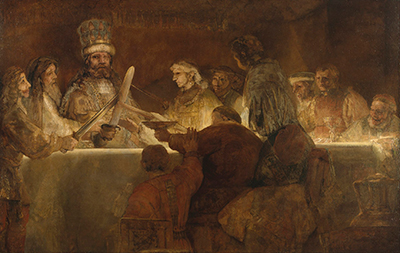This artwork from 1661-1662 was originally around five metres tall and wide before being cropped substantially to leave the fragment that we see here
Having been hung in the Amsterdam Town Hall it was later returned to Rembrandt, possibly because they could no longer afford to pay for it. The work was custom made for its intended position and as such the artist was a little bit confused as to what to do with it upon its return.
The Conspiracy of Claudius Civilis concerns a tale from the Batavian rebellion in 69–70 AD. He would arrange a feast for several key connections in order to gain support for a rebellion. Many then announced their backing to his plan through oathes taken at the same table. The painting itself features this very scene.
Feasts and large gatherings remind us of the excitement and community feel to much of the traditional life of years past. Rembrandt continued this theme with Belshazzar's Feast and who could possibly forget Leonardo da Vinci's The Last Supper. See also Religious Procession in Kursk Province by Ilya Repin and Peasant Wedding by Pieter Bruegel the Elder.
The original painting can be found in the Swedish National Museum in Stockholm and is officially owned by the Royal Swedish Academy of Fine Arts. Alongside this eye catching oil on canvas you will also find work by the likes of Peter Paul Rubens, Francisco de Goya, Pierre Auguste Renoir, Edgar Degas and Paul Gauguin. Local Swedish artists include Carl Larsson, C F Hill, Ernst Josephson and Anders Zorn.




